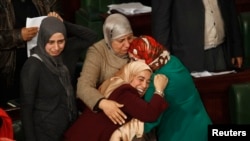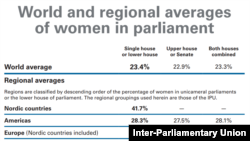Women made scarcely any progress increasing their presence in the top echelons of government last year, leaving gender equality in legislatures and ministries a distant goal, data showed on Wednesday.
A map ranking countries based on women in politics showed the number of women ministers and legislators barely rose, and the number of countries with a female head of state fell.
Progress getting women and men in equal numbers among the world's political leaders is at a near standstill, said the Inter-Parliamentary Union (IPU) and U.N. Women, which compiled the map.
"The overall stagnation and specific reversals are warning bells of erosion of equality that we must heed and act on rapidly," said Phumzile Mlambo-Ngcuka, executive director of U.N. Women.
Specifically, the number of women ministers nudged up to 732 from 730 in 2015, and their representation in parliaments rose less than a full percentage point to 23 percent. The number of countries with a female head of state or government fell to 17 from 19.
"These developments show that progress in gender equality remains slow in all structures of power and types of decision-making," IPU Secretary-General Martin Chungong said in a statement.
"Power is still firmly in men's hands," he said. The Swiss-based IPU works to promote representative democracy.
Nordic countries suffered the largest setback globally, with a 6 percent drop in women ministers. Overall, however, women account for 44 percent of the top political executives.
In Africa, women hold one-fifth of the ministerial posts but, with the exception of the Congo and Zambia, saw a steady decline over the last two years.
Finland, which had the most women ministers in 2015, saw a sharp fall to 39 percent from 63 percent. Finland now ranks 14th, while Bulgaria, France, and Nicaragua share first place.
In those three top countries as well as in Sweden and Canada, the number of women in ministerial positions is slightly more than half.
Rwanda has the highest ratio of female legislators, at nearly two-thirds in its lower house, followed by Bolivia, Cuba and Iceland.
North, Central and South Americas made significant gains over the year, with women comprising a quarter of the legislatures.
In Arab states, the biggest improvement was in Tunisia, where the ratio of women in parliament rose to 23 percent from 11 percent.








